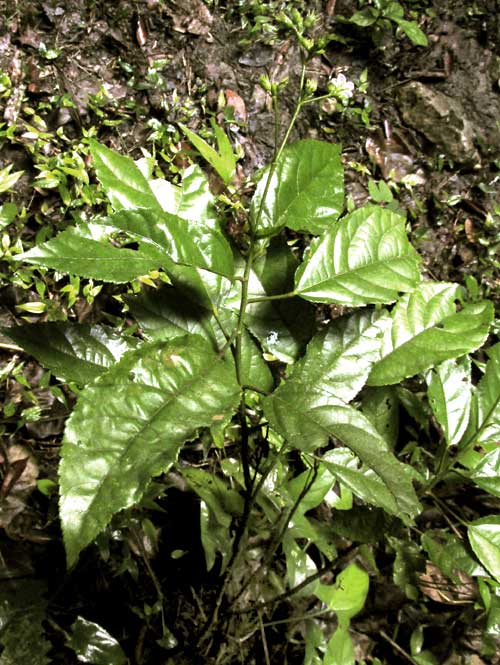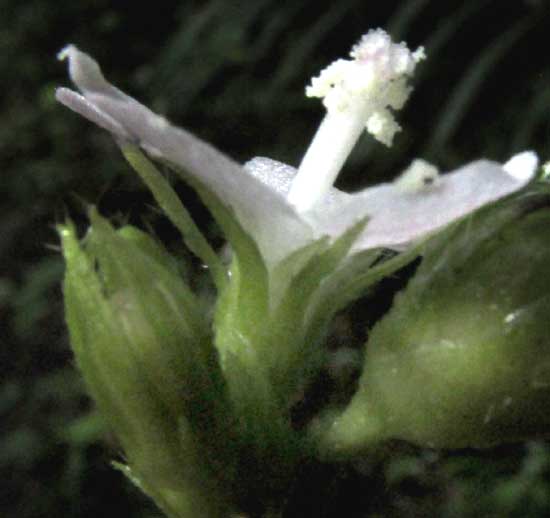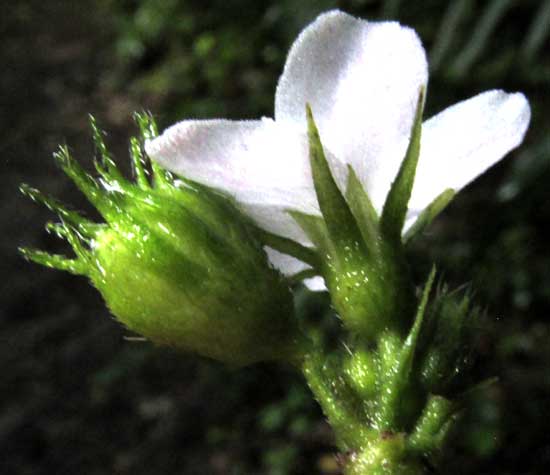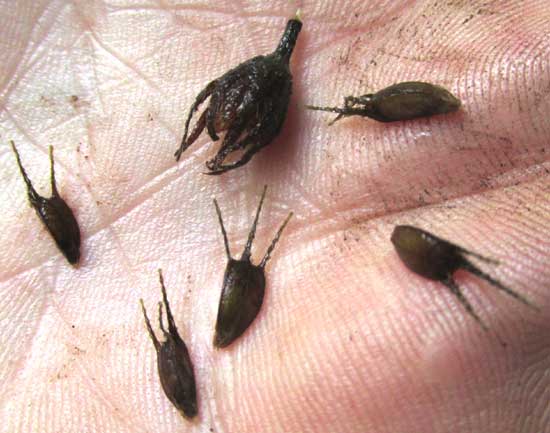Excerpts from Jim Conrad's
Naturalist Newsletter
from the December 7, 2018 Newsletter with notes from a camping trip into northern GUATEMALA
PAVONIA FLOWERING
Last September 30th during my camping trip into northern lowland Guatemala's Petén district, in El Rosario National Park on the eastern side of Sayaxché, a knee-high weed along a shaded dirt trail through the woods bore a single white flower, as shown below:

The plant had a tough, wiry, semi-woody and much branching base, and the leaves, though thin-bladed, also were tough and somewhat brittle. The blossom immediately revealed which plant family this belonged to, as you can see below:

With such pollen-releasing anthers clustered atop a slender tube formed by the stamens' fused filaments encircling the ovary's style, it has to belong to the big Hibiscus Family, the Malvaceae. Below, a view from below the blossom shows another feature of that family:

Flowers in the Hibiscus Family often have beneath their calyxes clusters of modified leaves called bracts. In the above picture the white corolla arises from a pale green calyx with five sharp-pointed sepals, and below that calyx arise eight long, slender, sharp-tipped bracts, forming an "involucre." Every hibiscus flower exhibits the same structure.
The Hibiscus Family is so big that even with flowers I doubted being able to identify this plant. In this family, often the fruits are needed, because -- different from many or most families of flowering plants -- there's greater easy-to-see variability among the fruits than the flowers. And then I saw that the plant bore an old fruit. The mature fruit broke into five fruit-like "mericarps," each mericarp topped with three barbed spines, as shown below:

These details were sure to reveal the plant's identity.
Many members of the Hibiscus Family, such as that of cotton and hibiscus itself, produce capsular fruits that do not break apart in this manner, so this fracturing fruit disqualified a lot of possibilities. The flower in our first picture also displayed a feature eliminating a very large number of genera: The white, baglike, pollen-producing anthers arose not at the very tip of the staminal column, but a bit below it.
These and other features led to the genus Pavonia, which is one of the largest genera in the Hibiscus Family, with 24 species listed for Mexico alone. With the help of Paul Fryxell's 1979 "Una Revisión del Género Pavonia en Mexico," and having those three-spined mericarps handy, it was easy to determine that our plant was PAVONIA SCHIEDEANA, one of the more widely distributed species, found from central Mexico and the Caribbean south through Central America into South America. In Spanish sometimes it's called Cadillo, but there is no good name for it in English, though Pavonia makes a pretty one, and is good enough for us here.
Having the name Pavonia schiedeana, we can look up the plant and see what's interesting about it.
In Mexico traditionally the species has been used in hair care. It's supposed to keep hairs from falling out, and prevents dandruff. It's also used to speed up childbirth, and to prevent abortion. It's been considered good for indigestion, diarrhea and the fever. For the fever, the stems and leaves are cooked, and the resulting liquid is used to bathe the patient, and injected into the rectum. Sometimes it's also been used for kidney problems, diabetes and bronchitis. In pharmacological studies, beta-sitosterol and tannins have been isolated from the roots.